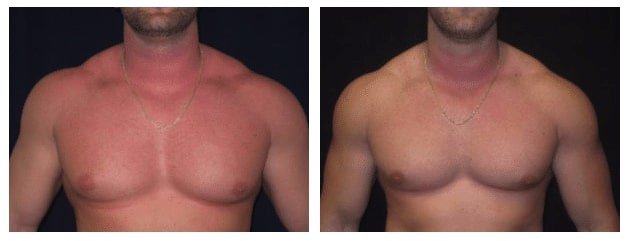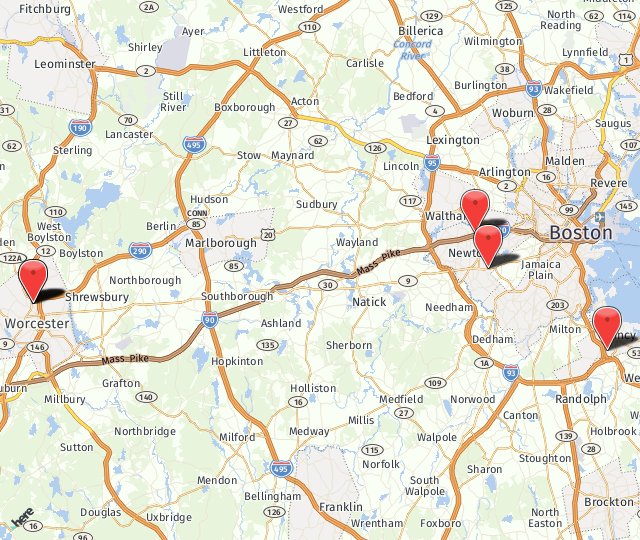The development of enlarged male breasts, also known as gynecomastia, affects an estimated 40 to 60 percent of men. This condition may be caused by a variety of factors such as side effects from drugs, hormonal imbalances, or genetics.
Men with enlarged or sagging breasts can become insecure. Men often don’t participate in activities due to feeling self-conscious. Gynecomastia surgery is a great way to decrease the size of the breast, helping him feel more confident and happy.

What Is Gynecomastia?
The term gynecomastia means “female-like breast.” The range varies from puffy nipples to full-on breasts. In any case, most men don’t want their chests to look like a woman’s chest.
Causes Of Male Breast Enlargement
Gynecomastia occurs due to an abnormality in the ratio of testosterone to estrogens in the body. When this ratio is low, the estrogen effect is stronger and stimulates the growth of the tissue around the breast. The testosterone which is most important is that which is not bound to protein in the blood, in other words, the free serum testosterone. This has been found to be lower in boys with gynecomastia compared to those without, while all the other hormone levels were about the same.
The abnormal hormone levels can occur in the newborn period due to maternal circulating estrogens, and also in older men, where testosterone levels are dropping, resulting in relatively more estrogen. Most often, these changes are physiologic and can be explained by normal processes in the body. Sometimes they are influenced by external factors, such as medications or anabolic steroids.
How Is Gynecomastia Diagnosed?
Gynecomastia starts as a little lump under the nipple, usually during puberty. The lump usually goes away with time, but not in all cases. Sometimes it gets bigger, causing the nipple to stick out. In a boy who is a little overweight, the chest might really start to look more like his sister’s chest with early breast development. Some kids can even squeeze a little fluid out of the nipple. It’s a pretty frightening experience for an adolescent, so lots of guys just ignore it hoping it will go away–unless their parents push them into seeing their doctor.
Gynecomastia Before And After
How Dr. Rick Silverman Performs Gynecomastia Surgery
Dr. Rick Silverman performs the male breast reduction surgery at the St. Elizabeth’s Medical Center located in Brighton, MA. The procedure is done in an ambulatory setting and an overnight stay is not needed. The procedure usually takes about one to two hours. If skin removal is required, it adds about an hour.
During the procedure Dr. Silverman will make two incisions on each side when resecting gynecomastia. He makes a small stab wound incision in the armpit area, which is not visible after surgery, and a second incision along the lower aspect of the areola, right on the color change. This makes it difficult to see this incision.

The procedure entails a combination of liposuction and direct excision of the mass under the nipple. Most patients go to sleep with a light general anesthetic, though the procedure can also be done with deep sedation. A type of local anesthetic, “tumescent anesthesia,” is administered to the area, and this helps to reduce general anesthetic needs. It also provides a result with less bleeding and a smoother contour afterwards.
Once the tumescent anesthetic is given, liposuction is carried out through the stab wound incision in the armpit area. Then a short incision is made along the lower end of the areola, and the “gland” is excised, leaving a small button of tissue under the areola to prevent nipple loss and reduce risk of “crater” deformity. Additional liposuction is carried out, followed by wound closure and application of a dressing.
Recovery From Male Breast Reduction Surgery
Recovery time for male breast reduction surgery varies from person to person. For some, they’ll feel great right away, whereas others return for their appointment 6 – 8 weeks post-op, still complaining about pain. This is less common. Most patients are back to normal within 4 to 6 weeks, but there will still be changes that occur for months afterward.
Post-operatively, you will wear a compression garment for 4 weeks. On the second post-operative day, the garment can be removed to shower. Patients will see steri-strips over the incisions and a gauze dressing, which can be thrown away. After showering, the garment is put back on, and it’s worn 24/7. After a week, Dr. Silverman will see patients back in the office to assess progress and change the steri-strips. Also, the patient can switch to a compression shirt (we recommend Spanx), which will be worn for another 3 weeks.
For competitive bodybuilders, Dr. Silverman will recommend that they do not plan to compete for 6 months post-op, since subtle swelling and other issues might be problematic.
Can Gynecomastia Cause Breast Cancer?
Gynecomastia is not cancer. It is a benign disease. Breast cancer in men is very unusual–Less than 1%, and this is generally in older men. Gynecomastia often occurs on both sides, so if a breast mass occurs on only one side, it may be more suspicious for cancer. It would be extremely unusual to see male breast cancer on both sides at the same time. Sometimes a patient’s history may give a clue as to whether or not the lump could be cancer. In other cases, a mammogram or ultrasound may be required. Sometimes a biopsy of the tissue must be done to be sure it isn’t cancer. Cancer arising in gynecomastia has been described in the medical literature, but it is very uncommon. Otherwise, everyone with gynecomastia would be encouraged to have it removed as a preventative measure.
Dr. Silverman’s Gynecomastia Patient

Gynecomastia FAQ’s
Is Gynecomastia Treatable?
Yes, gynecomastia is a treatable condition. In many cases, patients experience resolution of symptoms at the end of puberty, with discontinuation of certain medications, and weight loss. In other cases, patients may require surgical intervention if other non-surgical interventions are not successful.
Am I a Candidate for Gynecomastia Surgery?
To be eligible for breast reduction due to gynecomastia, you must have an excessive amount of breast tissue that does not respond to traditional measures. These include the cessation of puberty and weight loss, if applicable. If gynecomastia is caused by genetic predisposition, then weight loss and exercise may not correct the problem.
What Causes Gynecomastia?
Gynecomastia can develop for a variety of reasons, some of which include genetics, puberty, and hormonal imbalances. Weight gain and loss, as well as puberty, also play a significant role in the development of gynecomastia.
Are There Contrindicadictions to Having Gynecomastia Treatment?
Certain medications can prevent you from being a suitable candidate for surgical correction. Patients diagnosed with bleeding disorders, morbid obesity and other underlying medical conditions may not be suitable candidates for surgical intervention.
Are There Any Drugs To Take Before A Male Breast Reduction Procedure?
Patients are given a dose of prophylactic antibiotics on the OR prior to surgery, but no other drugs are used regularly.
When Can I Return To Normal Activities After My Gynecomastia Surgery?
Activity is limited for the first week. Low-impact Cardio can be resumed after a week, and resistance training can be incorporated at 2 weeks. No direct chest exercises for 4 weeks. Most patients who have Friday surgery can return to work on Monday, presuming they don’t do heavy lifting at work.
What Are Acceptable And Unacceptable Activities During The Healing Process After Male Breast Reduction Surgery?
The first week, patients should just take it easy. After a week, I permit cardio, and after two weeks, resistance training is allowed. No chest exercises for four weeks.
Light activity is permitted immediately, but patients shouldn’t do anything to increase heart rate or blood pressure to avoid bleeding or fluid accumulation.
During your Male Breast Reduction examination with Dr. Rick Silverman, he will perform a thorough chest exam and analyze your medical history looking for potential medical causes for Gynecomastia. For more information about this procedure check out our Gynecomastia Extended FAQ page.
Schedule A Consultation
If you have gynecomastia and would like to learn more about this cosmetic surgery, call (617) 965-9500 to schedule a consultation at our office serving the Boston area.


